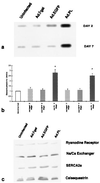Modulation of ventricular function through gene transfer in vivo
- PMID: 9560262
- PMCID: PMC20247
- DOI: 10.1073/pnas.95.9.5251
Modulation of ventricular function through gene transfer in vivo
Abstract
We used a catheter-based technique to achieve generalized cardiac gene transfer in vivo and to alter cardiac function by overexpressing phospholamban (PL) which regulates the activity of the sarcoplasmic reticulum Ca2+ ATPase (SERCA2a). By using this approach, rat hearts were transduced in vivo with 5 x 10(9) pfu of recombinant adenoviral vectors carrying cDNA for either PL, beta-galactosidase (beta-gal), or modified green fluorescent protein (EGFP). Western blot analysis of ventricles obtained from rats transduced by Ad.PL showed a 2.8-fold increase in PL compared with hearts transduced by Ad.betagal. Two days after infection, rat hearts transduced with Ad.PL had lower peak left ventricular pressure (58.3 +/- 12.9 mmHg, n = 8) compared with uninfected hearts (92.5 +/- 3.5 mmHg, n = 6) or hearts infected with Ad.betagal (92.6 +/- 5.9 mmHg, n = 6). Both peak rate of pressure rise and pressure fall (+3, 210 +/- 298 mmHg/s, -2, 117 +/- 178 mmHg/s, n = 8) were decreased in hearts overexpressing PL compared with uninfected hearts (+5, 225 +/- 136 mmHg/s, -3, 805 +/- 97 mmHg/s, n = 6) or hearts infected with Ad.betagal (+5, 108 +/- 167 mmHg/s, -3, 765 +/- 121 mmHg/s, n = 6). The time constant of left ventricular relaxation increased significantly in hearts overexpressing PL (33.4 +/- 3.2 ms, n = 8) compared with uninfected hearts (18.5 +/- 1.0 ms, n = 6) or hearts infected with Ad.betagal (20.8 +/- 2.1 ms, n = 6). These differences in ventricular function were maintained 7 days after infection. These studies open the prospect of using somatic gene transfer to modulate overall cardiac function in vivo for either experimental or therapeutic applications.
Figures






References
-
- Barry W H, Bridge J H B. Circulation. 1993;87:1806–1815. - PubMed
-
- Gwathmey J K, Bentivegna L A, Ransil B J, Grossman W, Morgan J P. Cardiovasc Res. 1993;27:199–203. - PubMed
-
- Koss K L, Kranias E G. Circulation Res. 1996;79:1059–1063. - PubMed
-
- Arai M, Matsui H, Periasamy M. Circ Res. 1994;74:555–564. - PubMed
-
- Hajjar R J, Kang J X, Gwathmey J K, Rosenzweig A. Circulation. 1997;95:423–429. - PubMed
Publication types
MeSH terms
Substances
Grants and funding
LinkOut - more resources
Full Text Sources
Other Literature Sources
Miscellaneous

